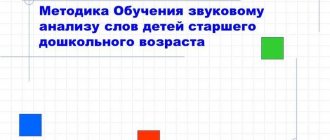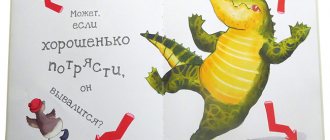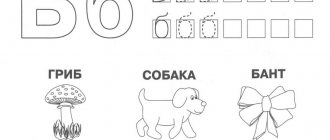Funny poems about the letter Sh for children
What do we have in the forest that starts with the letter Sh? This cone flopped, rustling. A bumblebee and a hornet are noisily rummaging through the porridge. Insects rustle in the rose hips. What else in the forest begins with the letter Sh? Noise and rustling near the hut. (M. Yasnov)
The mongrel barks very loudly. The mongrel knows very firmly: The one who says “woof” louder will always be right! (B. Zakhoder)
The balloon, playful, naughty, ran away with the wind, and where? And he didn't say it. (F. Bobylev)
The ball lay rolled up so that it wouldn’t run out the window. And now I’ll fool him, I’ll go out into the street with him. (G. Satir)
Scarf I was walking through the forest and was afraid... I came across someone’s scarf. Immediately the forest became less scary. - Hey, who lost the scarf? (G. Vieru)
I sewed a fur coat - I sewed a skirt, I sewed a hat - I sewed a slipper! Natasha is a good seamstress! (E. Blaginina)
Bumblebee sells balloons. The balls are so naughty! The balls rustle and burst into the sky, and the silken threads break. (G. Satir)
The bumblebee darted and rustled in the sage, the bumblebee made a terrible noise. He did so many things - he even woke up a hornet. (A. Pudval)
The sword swallower was not joking, he fearlessly swallowed five swords. Hey, naughty people! Increase your pace! Bring me the sixth sword. (V. Berestov)
Autumn bushes rustle. The leaves rustle on the tree. The reeds rustle. And the rain rustles. And the mouse, rustling, hurries into the hole. And there, six nimble little mice rustle quietly. But everyone around is outraged: - How naughty people rustled! (A. Usachev)
Speech therapy lesson “Sound and letter Sh”
Summary of the speech therapy lesson “Sound and letter Sh”
TASKS:
1. Automate the sound [w] in syllables, words, sentences. 2. Isolate sounds from words, divide words into syllables. 3. Phonemic analysis of words like CAT. 4. Introduce children to the letter Ш. 5. Read forward and backward syllables.
EQUIPMENT: object pictures, pencil cases, letters, sticks, toys.
PROGRESS OF THE CLASS.
1. Organizational moment.
The children are sitting in their places.
- Guys, look, guests have come to us. Let's get up, turn to the guests and say hello. — Today in class we will get acquainted with a new sound. But first, let's remember how a sound differs from a letter. (We pronounce and hear sounds, and we write and read letters).
We cannot see the sound, And we cannot pick it up. We can only hear the sound, and also say it.
— What two groups are all sounds divided into? (Sounds are divided into vowels and consonants.)
— How do vowels differ from consonants? (When pronouncing a vowel sound, the air does not encounter obstacles and therefore the sound can be drawn out for a long time. A consonant sound does not stretch because when it is pronounced, the air encounters obstacles).
The vowels are drawn to the ringing song. They may cry and sob. In the dark forest they call and hoot, But they don’t want to whistle and grumble.
And the consonants agree to rustle, whisper, creak, even snort and hiss, but I don’t want to sing to them.
2. Report the topic of the lesson. Characteristics of the sound [w] according to articulatory and acoustic characteristics.
— Now we will talk about a new sound. And music from the cartoon you know and love will help us with this. Children listen to music.
— Who remembered the author of the fairy tale on which this wonderful song was written? (This music is from the cartoon “Gena the Crocodile and His Friends” based on the fairy tale by Eduard Uspensky).
— Guys, name the heroes of the fairy tale “Crocodile Gena and his friends.” (This is Cheburashka, the girl Galya, the lion Chandra, the old woman Shapoklyak, the rat Lariska, etc.).
- Listen to who sings this song (Cheburashka’s song sounds). Look who came to visit us today. The speech therapist puts the Cheburashka toy on the desk.
- Cheburashka came to complain to us about a mischievous old woman who is preventing us from doing good deeds and helping people. Can you guess who it is? (Shapoklyak).
A drawing depicting the old woman Shapoklyak is put on the board.
- Right. Maybe today she will see what we do, such smart and diligent children, and she will also become smarter and kinder. Shall we help her with this?
- Do you know why the old woman is called Shapoklyak? She was named after the ancient headdress she wears.
- So, what is the first sound we hear in the old woman’s name? (This is the sound [sh]).
Articulation of sound (tongue cupped, lips rounded), characteristics (consonant, hard, voiceless).
- This sound has a peculiarity, it is never soft, always hard. Which hero's name has the same sound? (Cheburashka).
- In what part of the word do we hear it? (The sound [sh] is heard in the middle of the word).
3. Automation of the sound [ш] in syllables.
— Cheburashka came to our lesson from afar. He walked through the forest and listened. And the forest rustled: “Ash-osh-ush-ish!” (Cheburashka became wary). What-what-thing-thing! (I got scared.)" But then the leaves whispered: "Shu-shu-shu." And Cheburashka calmed down. What sounds did you hear in the whispering of the leaves? (Sounds [w], [y].) Complete them with the sound [m]. What word did you get? (Noise.) “Scatter” the sounds of the word noise. How many sounds does it have?
4. Phonemic analysis of words.
- Look who Cheburashka met on the way (bear, cat). Phonemic analysis of the words bear, cat.
5. Automation of the sound [sh] in words.
“Cheburashka came out of the forest and came to us.
a) Game “Name the picture”. Pictures of various colors are displayed. On the edge of the forest grew... (daisies, lilies of the valley, porridge), on the river... (water lilies, egg capsules). On the bank of the river Cheburashka saw ... (pebbles), on a pine tree - ... (cones), on a hazel tree - ... (nuts). Under the bush there grew... (red flowers). What bird did Cheburashka see on the tree? (Cuckoo.)
b) Game “Add a word”.
The speech therapist speaks on behalf of Cheburashka, and the children help lead the story.
-I was walking through the forest and a wave... (found). Then I went into the forest... (went), into the thicket of the forest... (went) and to the hut... (went), then into the hut... (went), nothing there... (found), then... (went). I ... (approached) to the tree, there I found sweet honey ... (found). Along the path... (went) and to your class... (came).
c) Game: “Lay out the pictures.” Dividing words into syllables.
— Cheburashka walked along the road and saw 3 houses. There are three houses on the board (one-story, two-story and three-story). The children have pictures on the table. Children should arrange their pictures into houses depending on the number of syllables in the word.
6. Physical exercise (carried out on the carpet).
- Listen to the poem and do the actions.
Make a circle! Wider circle! Friend on the right. Friend on the left. We walk in a circle, sing a song. Our group is friendly. We live happily.
Now get your hands ready.
The girls and boys in our group are friends. You and I will make friends with little fingers. One, two, three, four, five Start counting again. One, two, three, four, five We're done counting.
7. Automation of the sound [ш] in sentences. Analysis of the composition of the proposal.
- Now make up a sentence with your own word. The sentence must have five words. Show Cheburashka how we denote the words in the sentence. Proposal analysis.
- Cheburashka wants to play rhyming words with you. Look, he brought you an envelope. “Confused” verses are written here. Listen carefully and correct mistakes (children repeat correct sentences completely).
My friend and I played cups... (checkers). We drank tea from a white checker... (cup). A cone came out of the hole... (mouse). A mouse fell on her... (bump). There were cones sitting under the bush... (mice). There were mice hanging on the pine tree... (cones). A cat was flying in the air... (midge). The midge... (cat) lapped milk. There was a cat on the table... (a bowl). There was a bowl sitting on the floor... (cat).
8. Getting to know the letter Ш: tracing along the contour, typing it with your finger on the table, composing it with sticks.
- Oh, it looks like there’s something else in the envelope. Look, these are letters.
Reading syllables. Rule: the letter Y never comes after the letter Ш.
9. RESULT OF THE LESSON.
— Our guests really enjoyed the activity. Now Old Woman Shapoklyak will no longer misbehave and, like you, will go to school. Let's remember what we talked about today? Name words with the sound [sh]. The lesson is over.
Summary of a speech therapy lesson on the topic: Sound Sh. Letter Sh
Tweet
Ishmukhametova Liya Zufarovna
teacher speech therapist
MADOOU TsRR d/s No. 254
Ufa
Goal: clarification and automation of the sound Ш in speech. Introducing the letter Sh.
Tasks:
Correctional and educational: – teaching the acoustic-articulatory characteristics of the sound Ш based on various types of control; – consolidation of concepts: “consonant sound”, “syllable”, “word”; – consolidate the ability to identify the sound Ш in syllables and words;
Corrective and developmental: – automation of the pronunciation of the sound Ш in isolation, in syllables, words; – development of phonemic hearing and perception; – improvement of fine and gross motor skills and coordination of movements; – development of breathing and voice; – development of basic mental processes: attention, memory, thinking.
Correctional and educational: – develop skills of cooperation, mutual understanding, goodwill, and independence.
Equipment: Pictures with sound Ш, Image of the hero - Nyusha; Pictures “What does Beech Sh look like”; Typesetting canvas with letters; diagram - sound characteristics. Chest with object pictures; envelopes for each child: envelope No. 1 “Find the beech Ш”; envelope No. 2 letter Ш, syllables ША, ШУ from a split alphabet; envelope No. 3 letter constructor; envelope No. 4 with a stencil of capital and lowercase letters.
Progress of the lesson:
1.Organizing moment. The one whose name contains the sounds N, K, M, A will sit. 2. Message of the topic of the lesson. (A guest came to our lesson today and brought pictures. Name the pictures and identify the common sound in words. That’s right. Today in class we will remember the sound Ш, and get acquainted with the letter Ш; What our lips, teeth and tongue do when we pronounce the sound Sh?)
Articulation of sound (position of lips, teeth, tongue, air passage, voice) - lips are free;
Donut sponges.
The wide tongue at the top forms a “cup”.
A warm air stream flows through the center of the tongue.
The neck is “silent”.
3.Characteristics of sound according to acoustic characteristics. (Guys, what can we tell you about this sound?) The sound [Ш] is a consonant, hard, sonorous, denoted in blue. 4. Game “Catch the Sound” (Nyusha wants to see how attentive you are. I will name the words, and if you hear the sound [Ш], clap.)
r, b, g, w, r, s, z, w...; ra, zha, shu, ry, so, shi..; ar, osh, am, ur...; cancer, frost, cat, hedgehog, fur coat, games, reeds, axe, suitcase. (Well done! You are very attentive!)
5. Determining the place of a sound in a word. (Nyusha has prepared a chest with a task for you, take out the picture and find the place of the sound Ш in the word. Well done, you completed the task.)
6. Introducing the letter Sh. (The sound Ш is indicated by the letter Ш. Remember the rule about sounds and letters. (A card with a picture of the letter “Ш” is displayed). We see and write letters, and we hear and pronounce sounds. Look at the letter and try to come up with what she looks like.
Nyusha also loves to play with letters, this is what she did!)
Shura raked the hay,
I forgot my pitchfork in the hay.
Ah, the stool is good!
Turned it over, and the letter Sh.
The letter “Ш” is very simple, like a fence, straight, but it hisses, makes noise, rustles, speaks with a lisp, as if two teeth had fallen out, how will I teach it?
7. "Find the letter."
(Nyusha is going to go for a walk with the letter Sh, it’s cold outside, and the letter doesn’t have a hat, let’s give the letter Sh a real hat. We take out the envelope with the number... find the letter Sh and draw a hat for it. Now the letter Sh can safely go for a walk.)
8. Physical exercise. "The giraffe has spots"
9. Laying out the letter “Ш” from letter elements. ( Help Nyusha remember what the letter Sh looks like. Tell me, what elements does the letter Sh consist of? How are they located? Three sticks are located vertically, and the fourth is horizontal. Lay it out. Turn the letter Sh into the letter M, what needs to be done for this? And now again turn it into the letter Ш, Nyusha liked how you can turn letters.)
10.Reading syllables and words. Let's insert the letter Ш into the box of letters. The letter Ш has become friends with the letters A, U. We take the letter Ш and syllables out of the envelope and put it in the house. Now let's read them for Nyusha.
SHA UM MAMA MASH
SHU AM MARA NOISE
ASH MA MURA SHURA
USH MU RAMA HURRAY
11. Outlining and shading letters in notebooks.
(Nyusha suggests circling the letter Ш in the notebook. Open the notebooks. You need to retreat two cells from the top, two cells to the left, put the capital letter Ш in this corner, press the letter firmly to the notebook with your left hand, it
must be motionless. Take a pencil and carefully trace the letter. We draw the lines once and circle them. From the capital letter we retreat two cells to the right, apply a Small letter w, align it along the bottom line and outline it. After tracing the letters, we will hatch them with vertical lines. Look at the board: put a pencil in the upper left corner and draw down along the square, drawing vertical lines. Shading. Who has shaded, we put the notebooks on the edge of the table).
12. Summing up the lesson.
Let's remember what we talked about in class today?
What tasks did we complete?
Share on social media networks
I like
Summary of a literacy lesson (reading) “The Letter Sh.”
Item:
literary reading (learning to read and write).
Class:
1b.
Lesson topic:
Hard consonant sound [sh], letters Sh, sh.
Shea
combination .
Lesson type:
a lesson in discovering new knowledge.
Pedagogical purpose of the lesson:
Create conditions for students to become familiar with the hard consonant sound [sh], the letters Ш, Ш, for the development of speech, memory, and logical thinking.
Planned results:
Subject:
isolate the sound [w] from words, observe the pronunciation of a new sound in words, establish, based on observations, that the sound [w] is dull and always hard. Draw a conclusion (under the guidance of the teacher): these letters do not indicate how to pronounce the sound [w]; the sound [w] always remains hard.
Metasubject:
perceive the educational task, choose a sequence of actions, evaluate the progress and result of implementation. Construct logical reasoning, draw analogies, use generalized methods of action. Master monologue and dialogic forms of speech.
Personal:
show interest in acquiring and expanding knowledge and methods of action, a creative approach to completing tasks.
Formation of universal educational actions:
1. Personal:
formation of motivation for learning and knowledge; adequate self-esteem; willingness to openly express one’s position in the classroom, an adequate understanding of the reasons for success (failure) in the educational process.
2. Regulatory:
correlate the result of your activities with the goal and evaluate it.
3. Cognitive:
distinguish the new from the already known, characterize the letter Ш.
4. Communication:
learn to perform different roles in a team.
Educational Resources:
computer, TV, object pictures, cards with words, ABC textbook, counting sticks, word charts.
Technological lesson map
| Lesson stage | Teacher activities | Student activities | Forms, methods, methodological techniques |
| I. Organizational moment | - Today we have guests at our lesson, turn to the guests, smile, say hello, turn to face me. -We will create a good, friendly mood for the entire lesson. Smile at each other and at me! The lesson begins It will be useful for the guys. If you study letters Then let's learn to read. | Preparing the class for work. Listen carefully and hear the teacher and comrades. | Frontal. Verbal. Teacher's word. |
| II. Updating of reference knowledge (repetition of studied material). | - What two groups are letters divided into? -Tell me what you know about vowels. | For vowels and consonants. Vowel sounds can be sung. When pronouncing a vowel sound, the air does not encounter any obstacles. A vowel letter forms a syllable. | Frontal. Verbal. Conversation. |






